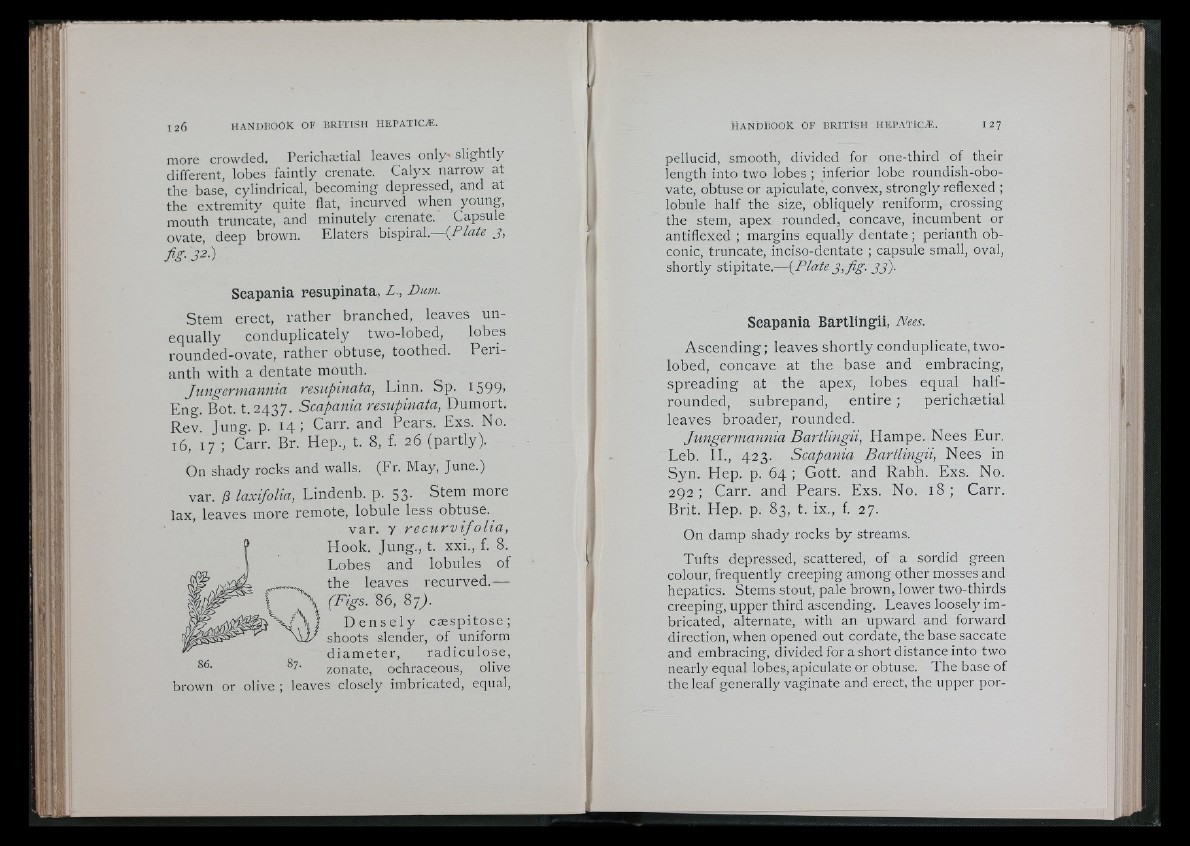
more crowded. Perichætial leaves only- slightly
different, lobes faintly crenate. Calyx narrow at
the base, cylindrical, becoming depressed, and at
the extremity quite flat, incurved when young,
mouth truncate, and minutely crenate. Capsule
ovate, deep brown. Elaters bispiral— j,
fig- 32-)
Scapania resupinata, L., Dum.
Stem erect, rather branched, ieaves unequally
conduplicately two-lobed, lobes
rounded-ovate, rather obtuse, toothed. P e r i anth
with a dentate mouth.
Jungermannia resupinata, Linn. Sp. i 5 9 9>
Eno-. Bot. t .2437 . Scapania resupinata, Dumort.
Rev. Jung. p. 1 4 ; Carr, and Pears. Exs. No.
16, 17 ; Carr. Br. Hep., t. 8, f. 26 (partly).
On shady rocks and walls. (Fr. May, June.)
var. /3 laxijolia, Lindenb. p. 53. Stem more
lax, leaves more remote, lobule less obtuse.
v a r . y r e c u r v i jo l ia .
Hook. Jung., t. xxi., f. 8.
Lobe s and lobules of
the leaves recurved.—
(Figs. 86, 87;.
D e n s e l y cæ s p i to s e ;
shoots slender, of uniform
d iam e t e r , r a d icu lo s e ,
zonate, ochraceous, olive
brown or olive ; leaves closely imbricated, equal.
pellucid, smooth, divided for one-third of their
length into two lobes ; inferior lobe roundish-obo-
vate, obtuse or apiculate, convex, strongly reflexed ;
lobule half the size, obliquely reniform, crossing
the stem, apex rounded, concave, incumbent or
antiflexed ; margins equally dentate ; perianth obconic,
truncate, inciso-dentate ; capsule small, oval,
shortly stipitate.— {Plate3, fig. 33).
Scapania Bartlingii, Nees.
A s c en d in g ; leaves shor t ly conduplicate, two-
lobed, concave at the base and embracing,
spreading at the apex, lobes equal halfrounded,
subrepand, entire ; perichaetial
leaves broader, rounded.
Jungermannia Bartlingii, Hampe. Ne e s Eur.
Leb, 11., 423. Scapania Bartlingii, Ne e s in
S yn. Hep. p. 64 ; Cot t . and Rabh. Exs. No.
2 9 2 ; Carr, and Pears. Exs. No. 1 8 ; Carr.
Brit. Hep. p. 83, t. ix., f. 27.
On damp shady rocks by streams.
Tufts depressed, scattered, of a sordid green
colour, frequently creeping among other mosses and
hepatics. Stems stout, pale brown, lower two-thirds
creeping, upper third ascending. Leaves loosely imbricated,
alternate, with an upward and forward
direction, when opened out cordate, the base saccate
and embracing, divided for a short distance into two
nearly equal lobes, apiculate or obtuse. The base of
the leaf generally vaginate and erect, the upper por